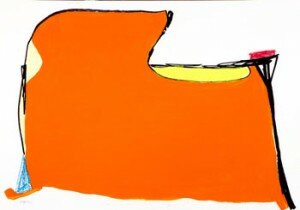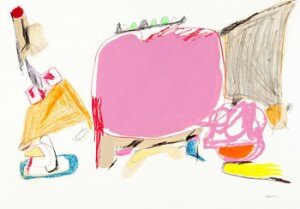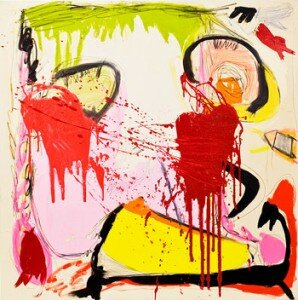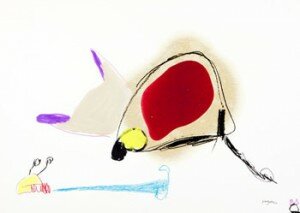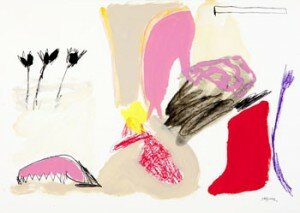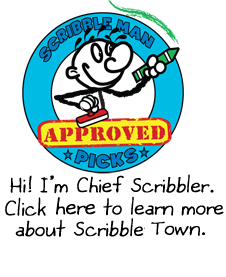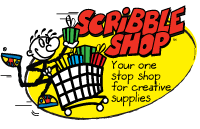Scribble Town (ST): Here with us on the Scribble Blog is Doris Sampson! Doris is an artist full of energy, stories, creativity, and much much more as you will soon find out. Doris, where are you and what are you up to these days?

See how I found shoes in this drawing? Added eyes to create a shy guy asking for a dance.
Doris Sampson (DS): I live in Duluth, Minnesota . . . U.S.A. This city is located at the western-most tip of Lake Superior, the largest of the Great Lakes. It’s awesome! Like living on the shore of an ocean, from our shore we cannot see land on the eastern horizon. Weather events can rile up some terrible storms, occasionally over even modern decades taking a freighter to the bottom of any one of the Great Lakes. The Big Lake is also our natural air conditioner. Because the temperature of the lake is always much cooler than the air, when we get a wind off the lake, Duluth can be significantly cooler as we’re situated in the valley of a big hill alongside the shore. Over the hill, much warmer! I like it this way because I’m no fan of hot weather!
DS: My career as an Artist spans 48 years, and I started Photography shortly after that, too. I’ve put tons of time and money into taking pictures, and since starting digital in 2002, in total over all my years, have tens and tens of thousands of pictures. Therefore, big chunks of time have gone into organizing those photos and since digital can fix OLD photos, in recent years lots of time has gone into restoring many, many photos from family albums covering my Finnish-American family heritage and history. I eventually will produce books about my personal memoir and probable historic photo books. I’ve also been a writer, starting with journaling at the end of 1977. I absolutely love writing, and my computer storage now contains working manuscripts for at least a dozen book concepts, with other ideas piling up behind those. But I need to update my computer equipment soon so I can better format manuscripts, and art/photos into them, too, to prepare them for electronic self-publishing. I love that option we have now!

The shape looked like a golf club, though wildly abstract!
ST: When did you start drawing and painting?
DS: As a child I was already a natural artist. I believe it was genetic as I’m 100% Finnish lineage–and the Finns are genetically extremely artistic. I loved doing art as a child, all the way through school to graduation. Because my family was farmer-laborer, I didn’t go to college for higher education–but was smart enough to have done that if there had been money. Instead, I never sat back on the learning process as a young adult–in any subject. But rather quickly did return to art . . . painting . . . about 5 years after graduation. I had two pre-school daughters by then, and began painting on the kitchen table–of course, needing to clean up scrupulously after each session! Especially because I’d started with oil paints–eventually switching to acrylics to avoid the fumes and possible other contact-toxins from handling oil paints. Especially Flake White, which has lead.
ST: Was there somebody that encouraged you?
DS: Yes, there was someone who inspired me as an artist starting from a very young age. Actually, my mother had painted as a teenager with a friend whose name was Marion. So it was seeing as a child craft pieces my mother had made so many years before by gluing fall leaves on the then-78rpm records. And then painting the leaves yellows, oranges, reds. There were three paintings my mother had done that still exist to today. So those were always on display in my grandparents’ farmhouse in Northern Minnesota. My father had also been artistic, and had begun art school when they lived in Detroit–I was born in a suburb, Ferndale, at that time. But he was drafted into World War II and had to quit art school. Only one drawing my dad did, of the violin maker, Stradevarius, existed then, and to date. It’s framed and hanging on a wall in my sister’s apartment here in Duluth. Neither of my parents were able to follow art as adults. My mom was a homemaker and my dad a laborer. Thank God he returned home from the war with just some back problems from a glider crash. He was in the Battle of the Bulge in the 101st Airborne Division–a terrible event during WWII.

Here is a scribble drawing that reveals a woman by how I filled in spaces with black ink.
Marion, as Mom’s girlhood friend since kindergarten (or maybe it was first grade then–did they have kindergarten so very long ago?) . . . was still her friend as I was growing up, and we’d visit her home in that rural area near my grandparents’ farm on occasion. Marion had taken up painting during her adult years, but did extremely few in total that I know of. One was a stunning portrait of a sister who had passed away, painted ethereally in blues, like the sky, her imagery as of angels. Riveting to me! Then, I believe this was after I was an adult with a toddler, as I recall one specific visit with my mom to Marion’s, with my daughter; she showed us another painting more recently done . . . a Moose in a Northern Minnesota swamp, edged with the typical swamp spruce and tamarac forest–a beautiful fall scene that I can see in my mind’s eye still. Marion was so special to me and I just soaked up her artist-ness into my soul!

This mushroom shape becomes one with some embellishment; not the different pen strokes creating varieties of texture.
My family was always supportive of my love of art and Nature as a child. I would do Paint-by-Number sets, and, again, I loved art in school. I would save my artworks and when several aunts and uncles came visiting from Detroit and Florida to Minnesota in the summers, I’d bring out those drawings and paintings to put on an ‘exhibit’ . . . and they’d give me a dollar! Guess what . . . I still have my best, saved artwork from the first dated to when I was 11 years old, through the 7th, 8th and 9th grades of junior high school! They can be seen on my website: dorissampson-lenscanvas.smugmug.com ! For so long I’ve wanted to be an inspiration to children, and here is my first opportunity!
ST: I bet you have been an inspiration to children even when you didn’t mean to be one. I’m impressed with you range of techniques! You even have collage and modeling pasted paintings. How did you discover and use this technique?
DS: I don’t remember right now what started the collage/modeling paste paintings. Since I’ve kept good records throughout my art career, it’s probably written down somewhere for me to find when I can start digging. But they were fun to do, using materials to build a foundation for a painting; then gessoing that ground (a primer layer); finally painting everything. Then, give it a wash of diluted burnt umber (brown) acrylic paint mixed in a lot of water and quickly wipe it off again with a soft rag–before it could dry. Then only a little bit of pigment would remain on the surface of the painting to provide a slight antiquey appearance to it.
ST: How do you handle moments when you get a zoom of inspiration?
DS: Since I do Art, Photography AND Writing, inspiration is more or less a constant on-going thing of which I can never keep up; as much as I would like to. So Art ideas get noted on paper, some started; Photos are a never ending job in my computer now; and my external hard drive is exploding with accumulated Writing projects, or notes and notes and more notes for those underway, and new project ideas. What I work on from day to day has no schedule–except to plow into whatever project/s are staring me in the face . . . NOW.

Color can be dropped into a drawing as desired on a computer, for me this was done in Photoshop4.
ST: What other forms of art do you practice? What are some tools you like to use to create?
DS: Art, Photgraphy and Writing take up all my work time creativeness. However, I am a ballroom dancer, and good at it. Genetic I’m sure as both my parents loved to dance and were great dancers in their early years. Raising a family, I only saw them dance about three times that I can remember. I sure wish I could see a movie of the years I was never a conscious part of! Dance is a wonderful, beautiful and happy form of Art!
ST: How do you find you models for your pen and ink drawings? There must be hundreds of beautiful portraits!

Here I wanted to make a heart shape with abstractions–a very fast swish, swish, swish with the hand kind of drawing.
DS: A couple of the people and pet pen and ink drawings you see are ones I did because I wanted to do them for myself. The rest are commissions from folks who saw my first portrait promotions starting around 2002. What you see in my website are what I’ve done. There might be another couple or so not shown, but I can’t remember at this writing.
ST: I’m sure there must be many, but what is one of your favorite songs?
DS: It’s probably better to ask what are my favorite genres of music. I love Finnish music that depicts my era of growing up–accordian and fiddle bands. There are two in particular I have tapes or CD’s of; Minnesota bands, “Third Generation” and “The Finn Hall Band”. Next, whenever I have an opportunity to work in my office AND listen to music at the same time, I’ll put on internet radio with Pandora.com . . . and I’m already keyed in to Classic Country-Bluegrass Gospel songs by historic Nashville voices from yesteryear to current singers who still have the same classic sound. On Sunday mornings, we have a local radio station, WKLK, that also plays those old gospel songs. I absolutely love them, and they are my inner Church every time I listen to them; filling me with the Spirit of God!
I also enjoy classical music on occasion; and my everyday favorite genre is the current “Music of Your Life” station that is streamed via many radio stations across America. Those songs truly depict the best pop songs I’ve heard over my 70 years of lifetime! So it would be more correct to speak of favorites in each genre–but that would be too big a project to do!
ST: Your art career has taken you on such a journey!
DS: I started my Scribble Drawings, which I now call my “Human Emotional & Thematic Caricatures . . . or Just Pure Art Form”, when I was taking drawing classes at a local university in 1985.

Do you see how you can add human emotion to a drawing than can be transformed into a man by adding teeth, an eye and a hat!?
University art classes were already far into the “modern” thing . . . be loose, let your mind wander, and finally . . . just scribble and see what happens. Well, I absolutely LOVED what I did with scribbles, learning immediately that the most important thing to remember is . . . WHEN TO QUIT! My personal take on it was to use quality pen and ink, and then take a good look at the scribbles to see if or what there was anything recognizable in the shapes. If so, then I’d start filling in space with my black ink to bring out that ‘something’ . . . or ‘someone’, if it had an abstract human element to it. Other times the shapes and forms depicted only abstract shapes and forms! So then I filled spaces in while keeping COMPOSITION in mind; to create Pure Art Form.
I did a large number of them around 1985, and it was the year 2000 when I took it up again. I was working on a book of poems about the subject of “Love” as a “mystery”. I wanted to illustrate the book and it occurred to me those 1985 drawings could be termed mysterious. When I checked them out, I discovered that many of my poems actually matched what some of the drawings seemed to be displaying. So I included them into my manuscript, and started doing the scribble drawings again here and there until now. I have about 250 of them now! These can be seen on my website also: dorissampson-lenscanvas.smugmug.com. Find this gallery under ART OF DORIS SAMPSON.
ST: Doris, thank you so much for sharing with us! You have shown us how to look at life, lines, and color in a different way with your creative scribbles! If you have any tips for parents and adults for how to create with children please let us know.

This drawing shape clearly resembled a pumpkin, so I gave it color and an abstracty kind of face!
DS: As for tips for parents, EVERY CHILD IS AN ARTIST! Provide the materials for them, and they will draw and/or paint. Display the Artworks. Choose the best from every year’s work and place these into an archival album–learn HOW to preserve art and photos archivally, don’t just glue or tape them in. There are album stores all over the country now. There is one online source I’ve been able to get oversize albums from in which to store my Scribble Drawings. It used to be called Century Plastics . . . don’t know if that’s a current name or not. These albums were acid-free, as I recall, with 12×18 pages of sturdy paper. A perfect ground for archiving your children’s artworks. The best of the best artwork/s–mat and frame them! I have some from my daughters. Once, when her dad and I went to a conference night, there were pastel painting pictures hanging all around the room–one by each child in that class. My eyes flew to one in particular that clearly shouted, “This child IS an Artist inside already!” It was so good compositionally, and with colors, lines, shapes and forms! Well . . . it was my daughter’s . . . a chip off the old block, going all the way back to both of her grandparents’ generation, too!
This daughter is now an assistant professor in the Art Department of a University in the State of Missouri! My other daughter is a Certified Public Accountant; and far on her way, too, of becoming a Nutritionist . . . already, via the internet, she is teaching people how to live and eat NATURALLY. That was something else our family did–we gardened organically, I canned and froze vegetables and fruits; and by golly, both grew up to follow in those footsteps. The Artist of my two daughters, and her husband, own an organic farm and apple orchard in Missouri!
ST: You are right, Doris, every child is an artist. Thank you 
Try these two Scribble Inspirations from Doris Sampson:
‘Yellow roses for my birthday’ and ‘Collage painting art project’

Ultimately I elaborated on the original (displayed above) by adding red and blue for a patriotic statement, “I Love America!” This is a wonderful example of how and why I plan to produce a line of products, such as greeting cards, from my drawings!
All photos: Copyright Doris Sampson 2013. Permission for free educational use for children granted. All Artist Reproduction-Distribution Rights Reserved. Contact Information: “. Feedback to Artist is welcome!”
